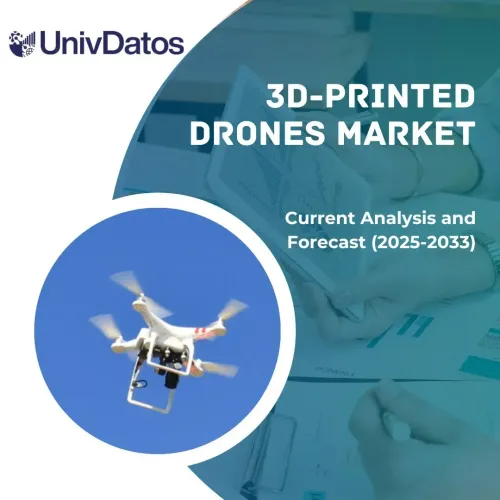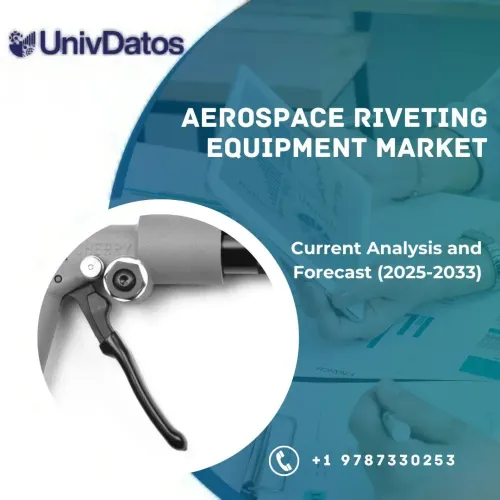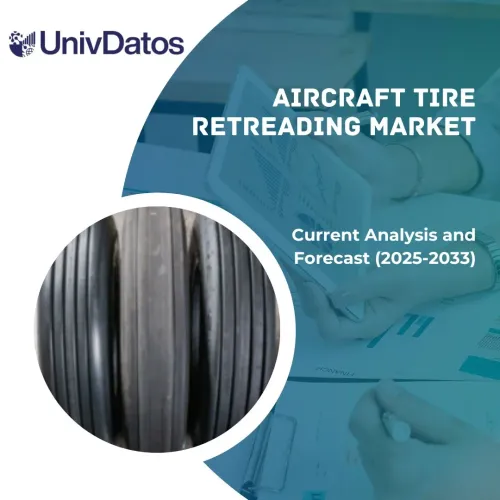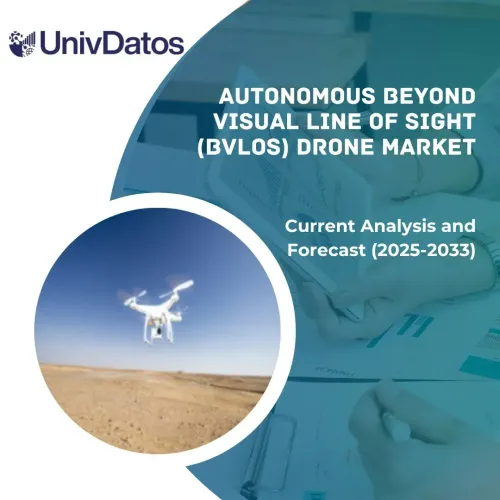- Home
- About Us
- Industry
- Services
- Reading
- Contact Us
Maritime Autonomous Surface Ships Market: Current Analysis and Forecast (2022-2030)
Emphasis on Level of Autonomy (Semi-autonomous, fully autonomous, Remote operation); Propulsion Type (Conventional, Hybrid, Fully Electric); Application (Commercial, defense).
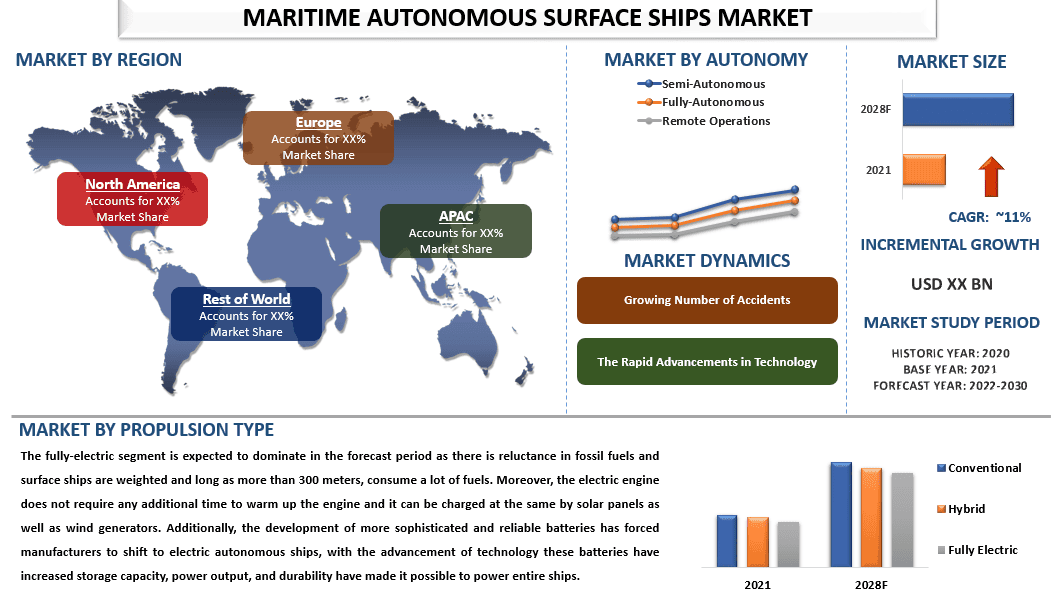
Maritime Autonomous Surface Ships Market was valued at USD 5.27 billion in 2021 & is expected to grow at a CAGR of 11% from 2022-2030 owing to increasing globalization and changing trade patterns. As global trade continues to grow, the increase in demand for faster, and more efficient shipping services needed that is cost-effective. With the increase in disposable income in the country such as China, and India the purchasing capacity of consumers has increased in the past couple of years. The demand for goods has been fulfilled by the e-commerce players in the region. As e-commerce has also seen robust growth due to the increase in globalization and changing patterns and habits of consumers. Companies are able to quickly move their products from one corner to another with the help of maritime autonomous ships, and that too is cost-effective. For instance, according to the report published by United Nations Conference on Trade and Development, a United nation body that aims to promote economic cooperation and development among its member state, reported Asia remained the world’s leading maritime cargo handling center in 2021, accounting for 42% of exports and 64% of imports, and Asian container exporters were among the top five, accounting for almost half the traffic, and included China, Viet Nam, the Republic of Korea and Japan. Therefore, the increasing globalization and changing trade patterns create the demand for consumer goods that too is fulfilled by the maritime autonomous surface ships.
Some of the major players operating in the market include Rolls Royce PLC; Mitsui & Co., Ltd.; Honeywell International Inc.; General Electric; Kongsberg Gruppen; NYK Line; L3Harris Technologies, Inc.; ABB; Yara International ASA; Samsung Heavy Industries. Several M&As along with partnerships have been undertaken by these players to facilitate customers with hi-tech and innovative products/technologies.
Insights Presented in the Report
“Amongst autonomy, the remote segment held a significant share of the market in 2021”
Based on autonomy, the market is segmented into semi-autonomous, fully-autonomous, and remote operations. The remote operations segment becomes the focal point in the maritime autonomous surface ships market in the forecast period as ships are equipped with advanced security systems. Moreover, remote operations have a plentiful advantage as they eliminate human error, increase the safety for life, reduce crewing costs, and allow the operation of more than one crew member at the same time. Additionally, it also allows more efficient use of space in ship design and efficient use of fuel. A three-year research project by MUNIN (Maritime Unmanned Navigation through Intelligence in Networks) has shown that these ships can lead to significant cost savings over the long term. According to the project, autonomous vessels can reduce fuel consumption and crew supplies, and salaries by over USD7 million over 25 years. This is a significant saving, and it’s no wonder that so many ship operators are interested in exploring the possibilities of autonomous ships, especially in remote operations.
“Amongst propulsion types, the fully electric segment held the majority share of the market in 2021”
Based on propulsion type, the market is segmented into conventional, hybrid, and fully electric. The fully-electric segment is expected to dominate in the forecast period as there is reluctance in fossil fuels and surface ships are weighted and long as more than 300 meters, consume a lot of fuels. Moreover, the electric engine does not require any additional time to warm up the engine and it can be charged at the same by solar panels as well as wind generators. Additionally, the development of more sophisticated and reliable batteries has forced manufacturers to shift to electric autonomous ships, with the advancement of technology these batteries have increased storage capacity, power output, and durability have made it possible to power entire ships, and the recharging time is also decreased. Moreover, electric autonomous ships also use regenerative braking, which uses energy from the ship’s motion and converts it into electrical energy, further providing support to the ships and increasing efficiency.
“Asia Pacific dominated the maritime autonomous surface ships market in 2021”
The Asia Pacific region is projected to be the fastest-growing region in the forecast period as the region is having the most number of production units in countries such as China, India, and Vietnam. These countries are the hub of production units of electronic appliances, and brown and white goods that are exported all over the world. Therefore, the increase in trade between countries has risen the demand for maritime autonomous surface ships. Moreover, the region has a greater number of fleets in countries like India, and China, and an increase in tourism & recreational activities has further increased the demand for the market.
Maritime Autonomous Surface Ships Market Report Coverage

Reasons to buy this report:
- The study includes market sizing and forecasting analysis validated by authenticated key industry experts.
- The report presents a quick review of overall industry performance at one glance.
- The report covers an in-depth analysis of prominent industry peers with a primary focus on key business financials, product portfolios, expansion strategies, and recent developments.
- Detailed examination of drivers, restraints, key trends, and opportunities prevailing in the industry.
- The study comprehensively covers the market across different segments.
- Deep dive regional level analysis of the industry.
Customization Options:
The global maritime autonomous surface ships market can further be customized as per the requirement or any other market segment. Besides this, UMI understands that you may have your own business needs, hence feel free to connect with us to get a report that completely suits your requirements.
Table of Content
Research Methodology for the Maritime Autonomous Surface Ships Market Analysis (2022-2028)
Analyzing the historical market, estimating the current market, and forecasting the future market of the global maritime autonomous surface ships market were the three major steps undertaken to create and analyze the adoption of maritime autonomous surface ships in major regions globally. Exhaustive secondary research was conducted to collect the historical market numbers and estimate the current market size. Secondly, to validate these insights, numerous findings and assumptions were taken into consideration. Moreover, exhaustive primary interviews were also conducted, with industry experts across the value chain of the global maritime autonomous surface ships market. Post assumption and validation of market numbers through primary interviews, we employed a top-down/bottom-up approach to forecasting the complete market size. Thereafter, market breakdown and data triangulation methods were adopted to estimate and analyze the market size of segments and sub-segments of the industry pertains to. Detailed methodology is explained below:
Analysis of Historical Market Size
Step 1: In-Depth Study of Secondary Sources:
Detail secondary study was conducted to obtain the historical market size of the maritime autonomous surface ships market through company internal sources such as annual reports & financial statements, performance presentations, press releases, etc., and external sources including journals, news & articles, government publications, competitor publications, sector reports, third-party database, and other credible publications.
Step 2: Market Segmentation:
After obtaining the historical market size of the maritime autonomous surface ships market, we conducted a detailed secondary analysis to gather historical market insights and share for different segments & sub-segments for major regions. Major segments are included in the report as Level of autonomy, propulsion type, and application. Further country-level analyses were conducted to evaluate the overall adoption of testing models in that region.
Step 3: Factor Analysis:
After acquiring the historical market size of different segments and sub-segments, we conducted a detailed factor analysis to estimate the current market size of the maritime autonomous surface ships market. Further, we conducted factor analysis using dependent and independent variables such as Level of autonomy, propulsion type, and application of the maritime autonomous surface ships market. A thorough analysis was conducted for demand and supply-side scenarios considering top partnerships, mergers and acquisitions, business expansion, and product launches in the maritime autonomous surface ships market sector across the globe.
Current Market Size Estimate & Forecast
Current Market Sizing: Based on actionable insights from the above 3 steps, we arrived at the current market size, key players in the global maritime autonomous surface ships market, and market shares of the segments. All the required percentage shares split and market breakdowns were determined using the above-mentioned secondary approach and were verified through primary interviews.
Estimation & Forecasting: For market estimation and forecast, weights were assigned to different factors including drivers & trends, restraints, and opportunities available for the stakeholders. After analyzing these factors, relevant forecasting techniques i.e., the top-down/bottom-up approach were applied to arrive at the market forecast for 2028 for different segments and sub-segments across the major markets globally. The research methodology adopted to estimate the market size encompasses:
- The industry’s market size, in terms of revenue (USD) and the adoption rate of the maritime autonomous surface ships market across the major markets domestically
- All percentage shares, splits, and breakdowns of market segments and sub-segments
- Key players in the global maritime autonomous surface ships market in terms of products offered. Also, the growth strategies adopted by these players to compete in the fast-growing market
Market Size and Share Validation
Primary Research: In-depth interviews were conducted with the Key Opinion Leaders (KOLs) including Top Level Executives (CXO/VPs, Sales Head, Marketing Head, Operational Head, Regional Head, Country Head, etc.) across major regions. Primary research findings were then summarized, and statistical analysis was performed to prove the stated hypothesis. Inputs from primary research were consolidated with secondary findings, hence turning information into actionable insights.
Split of Primary Participants in Different Regions
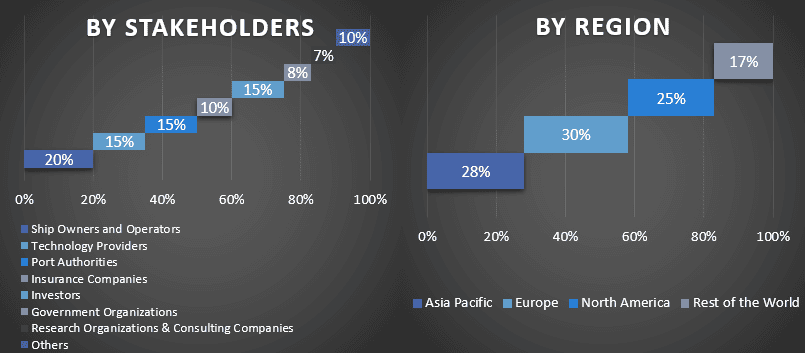
Market Engineering
The data triangulation technique was employed to complete the overall market estimation and to arrive at precise statistical numbers for each segment and sub-segment of the global maritime autonomous surface ships market. data was split into several segments & sub-segments post studying various parameters and trends in the areas of the Level of autonomy, propulsion type, and application in the global maritime autonomous surface ships market.
The main objective of the Global Ride-Sharing Market Study
The current & future market trends of the global maritime autonomous surface ships market were pinpointed in the study. Investors can gain strategic insights to base their discretion for investments on the qualitative and quantitative analysis performed in the study. Current and future market trends determined the overall attractiveness of the market at a regional level, providing a platform for the industrial participant to exploit the untapped market to benefit from a first-mover advantage. Other quantitative goals of the studies include:
- Analyze the current and forecast market size of the maritime autonomous surface ships market in terms of value (USD). Also, analyze the current and forecast market size of different segments and sub-segments
- Segments in the study include areas of the Level of autonomy, propulsion type, application
- Define and analysis of the regulatory framework for the maritime autonomous surface ships industry
- Analyze the value chain involved with the presence of various intermediaries, along with analyzing customer and competitor behaviors of the industry
- Analyze the current and forecast market size of the maritime autonomous surface ships market for the major region
- Major countries of regions studied in the report include Asia Pacific, Europe, North America, and the Rest of the World
- Company profiles of the maritime autonomous surface ships market and the growth strategies adopted by the market players to sustain in the fast-growing market
- Deep dive regional level analysis of the industry
Related Reports
Customers who bought this item also bought




